Prudence
When I discovered Prudence, I was immediately impressed by her authentic, caring, and hard-working approach to her work and her health journey to deal with stress after some serious life challenges.
Prudence Davis is the founder of the exclusive Pilates reformer & wellness studio A Space to Breathe, where she creates a sanctuary for deep healing and sustainable vitality. She has also created the matcha brand 20Four together with her husband, has her own podcast Healthline, and is the author of a soon-to-be-published book on the intersection between modern medicine and holistic health. She is, in other words, a hard-working woman and a truly pioneering voice in the health & wellness space—blending physical and mental well-being into everything she touches. When she’s not teaching, writing, or recording, you’ll find her behind the DJ decks or at home in Copenhagen with her husband Jonas and their cats Fluffy & Marley— preparing to welcome twins this spring.
What is your daily practice to feel grounded and create space for yourself?
My daily practice to feel grounded and create space for myself is really about keeping things simple, intentional, and connected to the body. I always start my day by slowing down—whether it's through breathwork, a short meditation, or a mindful Pilates flow that helps regulate my nervous system. It doesn’t have to be long; it just has to be real.
Matcha is also part of my ritual. The process of preparing it—sifting, whisking, slowing down to sip—becomes a form of moving meditation. It gives me calm, sustained energy and a sense of presence, especially on busy days.
Some days I add in contrast therapy or sound to shift energy, but overall, it’s about tuning into what I need at that moment. Thermal therapy, especially the dance between heat and cold, has taught me so much about resilience. Stepping into the discomfort of an ice bath or surrendering to the intensity of the sauna reminds me that growth often happens in the in-between spaces — when we meet the edge of our comfort zone and choose to stay, breathe, and soften. It’s a practice in nervous system regulation, but also in trust — in the body, in the moment, in the cycle of challenge and recovery.
I've come to believe that being comfortable with being uncomfortable is one of the greatest tools for longevity, clarity, and inner strength. That’s why contrast therapy is more than just physical; it’s a mindset, a reminder that I can meet what comes — calmly, steadily, and with breath.
I’ve learned that less really is more. Creating even small pauses throughout the day gives me space to breathe — something I try to carry into everything I create, from A Space to Breathe to my work with clients and collaborators. It’s not about striving, but about softening. Not about perfection, but presence.
What inspired you to create A Space to Breath?
The inspiration behind A Space to Breathe came from a very personal place. After years of creating healing sanctuaries and holding a waitlist for almost three years, I felt it was finally time to bring something truly special to life—a space I had longed for myself. I wanted to create something intimate, with limited spots, where quality, presence, and authenticity come first.
A Space to Breathe was born out of a deep need for something slower, more grounded—a place where both the body and mind can be supported. I wanted to blend ancient wisdom with high-end technology, and to offer an experience that nourishes the nervous system, fosters strength, and prioritizes presence. After each session, we serve ceremonial matcha and offer cryo facials, because the experience doesn’t end when the class does. It’s about creating a full moment of care.
For me, less is more. I’ve seen how deeply people are craving genuine connection and high-quality spaces that aren’t overwhelmed by crowds. A Space to Breathe is not just a studio—it’s a little dream of mine brought to life. A place of stillness in the heart of a busy city. A space where I, too, can truly breathe.
How have your routines changed after finding out that you were pregnant with twins?
Finding out I was pregnant with twins invited a whole new level of awareness and softness into my daily rituals. Everything became more intentional — not about doing more, but about tuning in deeply to my intuition and trusting what my body was telling me.
I leaned into the practices that helped me feel most grounded: gentle movement, breathwork, red light therapy, and moments of stillness. Red light became a daily ritual — both calming and energizing — while cold therapy remained a powerful tool to reset, regulate, and reconnect with my breath. Even during pregnancy, stepping into the cold reminded me that I’m capable of meeting discomfort with presence — a lesson that feels especially relevant when growing two little humans at once.
Pilates has been a constant, especially Reformer work. It’s been incredibly supportive for my pelvic floor, posture, and core connection as my body shifts and expands. It’s helped me feel strong from the inside out, and has allowed me to keep doing what I love in a way that feels nourishing, not depleting.
I’m almost at week 35 now, and I’m still able to do strength training and bike, simply because I’ve followed my body’s lead every step of the way. Some days are about movement; some days are just about breath and quiet. I've also learned to prioritize more clearly than ever — to say no without guilt, and yes to what truly supports me.
Ultimately, this journey has deepened everything I already believed in: that less is more, intuition is everything, and presence is the most powerful practice of all.
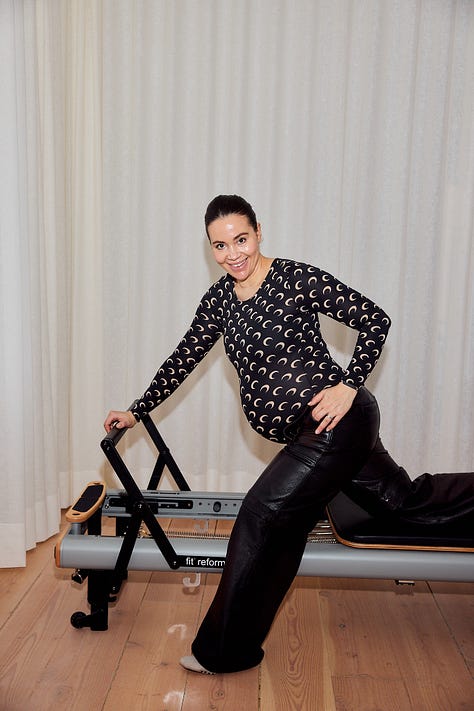
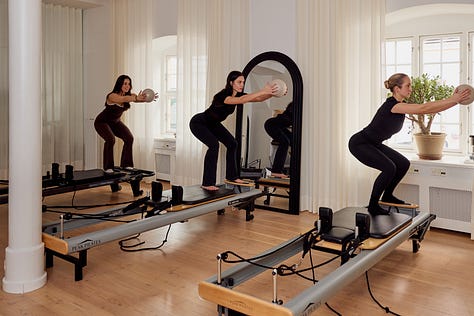
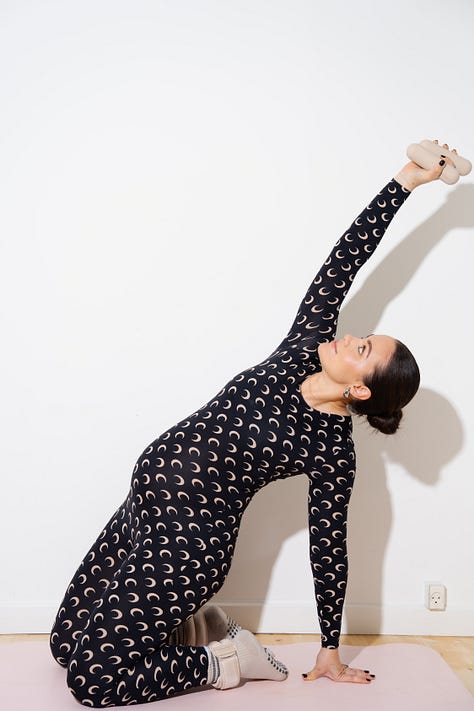
What is the most important thing you learned from your mother? And what are the most important values you want to teach your children?
My mother taught me the quiet strength of consistency — that care doesn’t always have to be loud or dramatic to be deeply felt. She showed me that presence is a form of love, and that creating a calm, grounded atmosphere can shape a whole childhood. Her way of moving through life — with warmth, softness, and steady hands — made me feel safe enough to explore, fall, and grow. That’s something I carry with me every day.
I want to teach my children to stay close to themselves — to listen inward before reacting outward. That their worth isn’t measured by how much they do, but by how connected they are to who they are. I want them to know that it's okay to rest, to feel deeply, to say no, and to take up space — softly and fully.
Curiosity, kindness, and the courage to be present in both beauty and discomfort — those are the values I hope they grow up with. And above all, I want them to feel that their home is a place where they can always breathe, just as they are.
In your podcast Healthline, you talk about how you can get high on your own supply, what do you mean by that?
To me, “getting high on your own supply” is about accessing the natural states of clarity, focus, energy, and deep calm that already live inside us — without relying on anything external. It’s that internal shift that happens through breathwork, movement, thermal therapy, and presence — a kind of body-led intelligence that taps directly into your nervous system. It’s real, it’s chemical, and it’s incredibly powerful.
The idea for Healtline came from years of guiding clients and constantly referring them to treatments, supplements, and tools that had helped me personally — always wanting to connect them to the best people in the industry, because I’ve tried a lot, and I know how much discernment it takes. But I also noticed a gap: people were curious, but often didn’t really understand why these methods worked, or how to use them intentionally.
So I created Healtline to go deeper — to combine personal experience with science, somatics, and biohacking in a way that feels human. It’s a space where we unpack how things like red light therapy, cold exposure, breathing techniques or even ritual can shift our biochemistry — and help us feel more resilient, more present, more alive.
Forme, this is biohacking at its most intuitive: tuning into the body, understanding the mechanisms behind it, and making small, repeatable choices that change how we show up in the world. That’s what I mean when I say: you can get high on your own supply— because the most powerful tools are already within you. We just need to remember how to access them.
How do you stay inspired in your life and work? Do you have any expanders?
The truth is, I don’t really need to seek inspiration — I meet it every day. I’m surrounded by so many creative, passionate people through my work, and I feel incredibly lucky to be doing something I truly love. Whether I’m guiding clients, co-creating with practitioners, working with brands, or holding space at A space to breathe, I’m constantly witnessing moments of transformation, vulnerability, and connection. That alone fills me up.
Inspiration also flows through my creative projects — from my matcha brand and daily rituals, to Healtline, where I get to have deep, meaningful conversations with guests who are shaping the future of health and wellness. Each interview feels like a window into a new way of thinking, being, or healing.
Right now, I’m also co-writing a book with the brilliant Doctor Tina Horsted — and that process has expanded me in ways I couldn’t have predicted. It’s opened up a space for reflection, for clarity, and for putting language to experiences that are usually felt more than spoken. It’s inspiring me to slow down and go deeper.
Nature continues to be a huge expander for me — the way light changes, the sound of breath, the ritual of making matcha — these small moments keep me grounded and open. And of course, the people I surround myself with — artists, thinkers, mothers, movers — inspire me just by being who they are.
Inspiration, for me, is a byproduct of living in alignment, staying present, and being willing to say yes to what feels real. I don’t need to chase it — I just need to keep showing up.
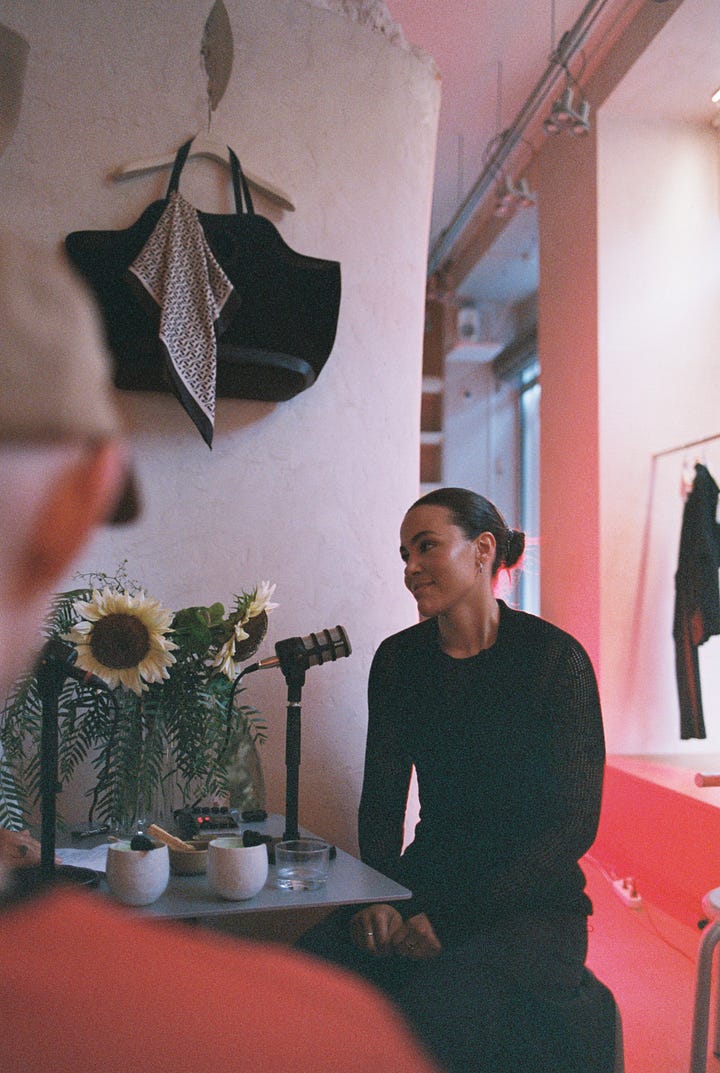
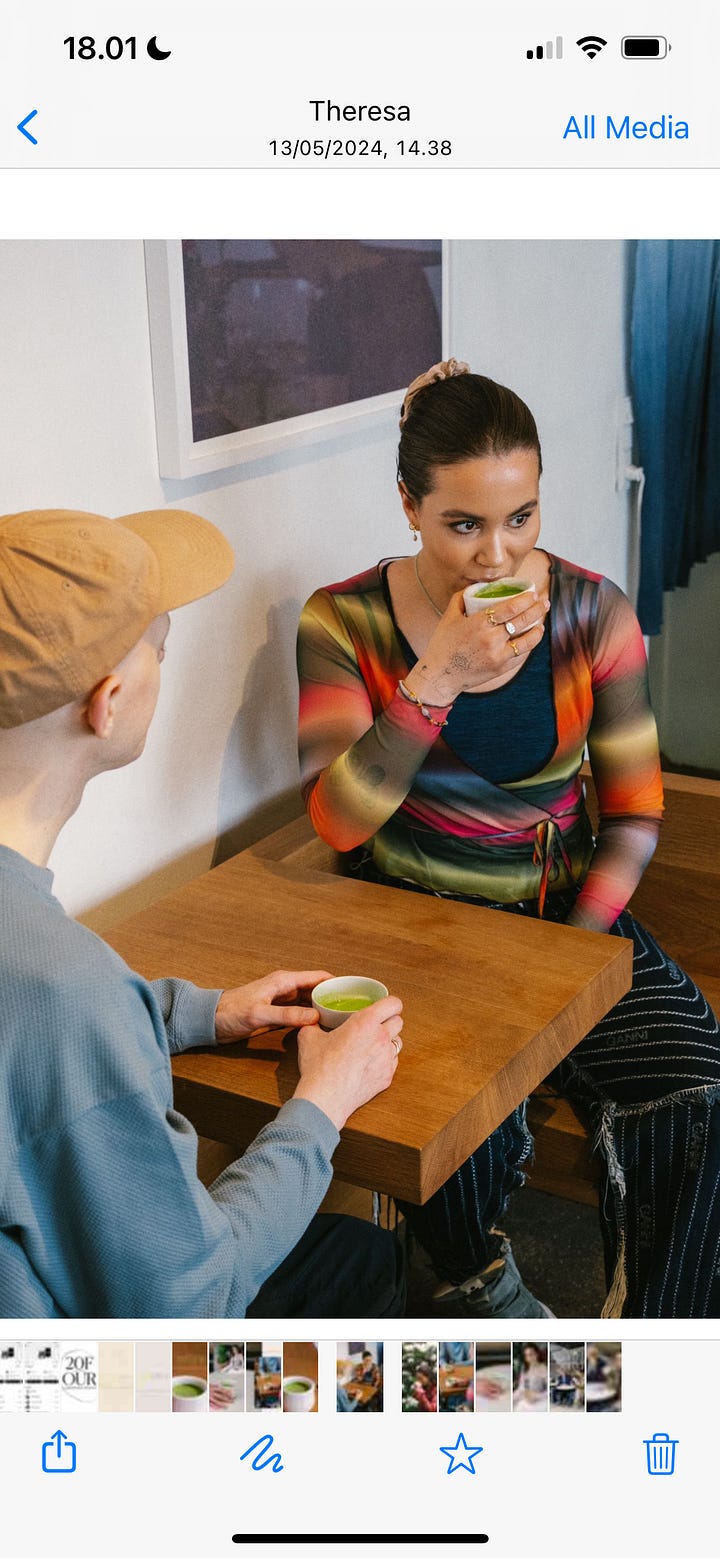
What advice do you have for other women dreaming of creating a sustainable & authentic work-life?
Start by getting radically honest with yourself — not about what looks good on paper, but about what feels good in your body. Sustainability isn’t just about structure or strategy — it’s about your nervous system, your energy, your capacity. If your work constantly drains you, it’s not sustainable, no matter how “successful” it looks from the outside.
Your health has to come first. Not just physical health, but emotional, mental, and energetic health too. When you build a life or business that supports your well-being, everything else flows from there — creativity, clarity, connection. It's not selfish; it's foundational.
Allow yourself to go slower than the world expects. Authenticity takes time. Don’t be afraid to say no, to rest, to change direction. Some of the most powerful choices you’ll make are the quiet ones — the ones that protect your peace and preserve your energy.
Surround yourself with people who expand you, not drain you. Stay close to your intuition. And remember: you don’t have to do everything at once. Start small, stay grounded, and build something that feels like you — not a version of success you’ve been told to chase.









